Fast Company on the latest in neurotech:
While their roundtable discussion admittedly sounded like a master’s exercise in strange science, the kicker is that all three are engaged in preliminary efforts to make this happen. Last year, at the resolutely mainstream MIT Media Lab, I saw Dr. Berger speak about hacking the memories of rats. Berger’s lab at USC is actively working on prosthetic brain implants that both falsify memories and stimulate brain function in damaged neurons. The lab’s work recently received media attention when it successfully generated new memories in a rat that had its hippocampus chemically disabled. In literature, Berger emphasizes his technology’s potential for treating Alzheimer’s and dementia through the possibility of “building spare parts for the brain;” on-stage in New York, he said it could also lead in the future to full-on brain transplants.
This would work in tandem with Kaplan’s and Lebedev’s specialties. The two Russian scientists research brain-computer interfaces (BCIs)–plug-in interfaces which meld the human brain and nervous system to computer operating systems. While BCIs are most commonly found in toys that read brainwaves to detect stress or concentration, they have revolutionary potential to change the lives of stroke victims and the disabled.
Full Story: Fast CoExist: Not Science Fiction: A Brain In A Box To Let People Live On After Death






